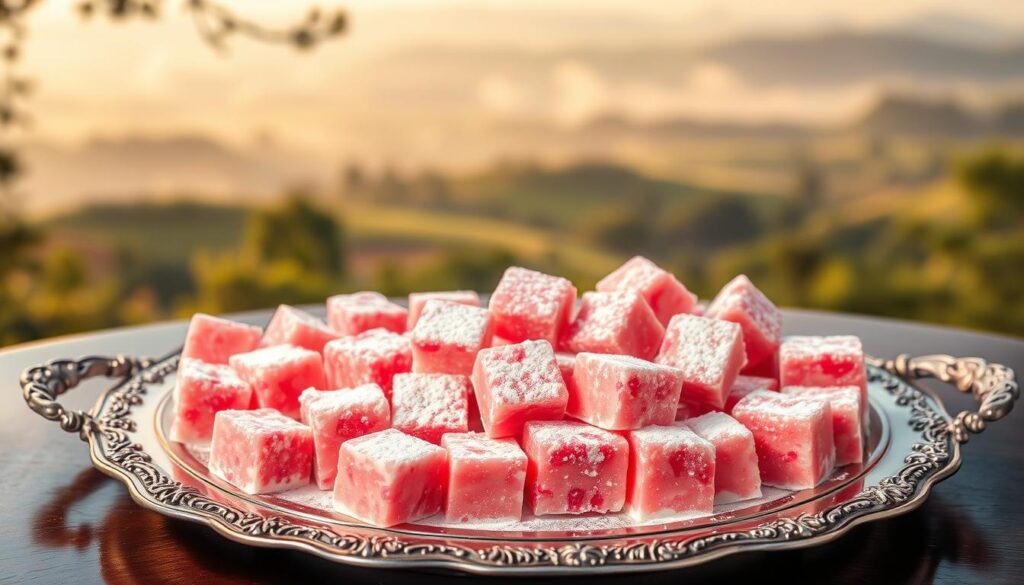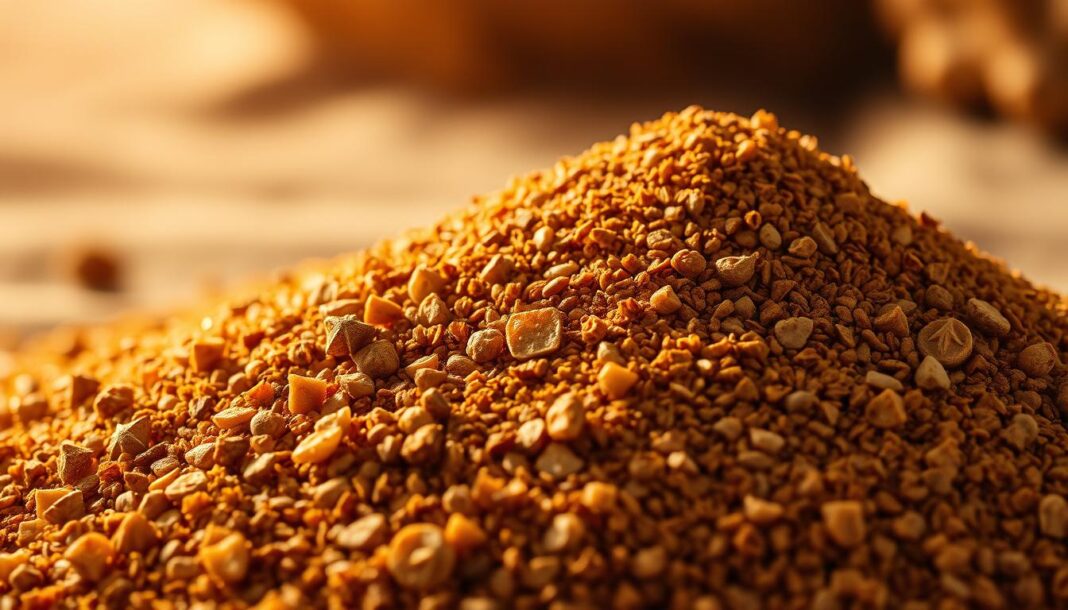The enchanting world of Turkish Delight, also known as Lokum, has captivated many with its sweet, gummy texture and rich flavors. Made with starch and powdered sugar, this confectionery is often infused with rosewater or lemon, creating a unique taste experience.
In C.S. Lewis’s beloved Chronicles of Narnia, Turkish Delight plays a pivotal role as a tool of temptation wielded by the White Witch. Edmund Pevensie’s encounter with this magical candy is a turning point in the story, showcasing its addictive nature and the Witch’s cunning.
As we explore the cultural significance of Turkish Delight both in our world and within the magical realm of Narnia, we uncover its traditional ingredients and the role it played in captivating readers’ imaginations. For more insights, visit Turkish Delight Narnia Quote and Edmund Turkish Delight.
Key Takeaways
- Understanding the cultural significance of Turkish Delight in Narnia and its real-world counterpart.
- Exploring the traditional ingredients that make Turkish Delight unique.
- The role of Turkish Delight in the narrative of The Chronicles of Narnia.
- How the White Witch used Turkish Delight to manipulate Edmund Pevensie.
- The historical context of Turkish Delight and its appeal to readers.
The Enchanting Allure of Turkish Delight in Narnia
C.S. Lewis masterfully used Turkish Delight as a literary device in the Chronicles of Narnia, transforming an ordinary candy into a symbol of temptation and betrayal. In the story, the White Witch uses this enchanting food to manipulate Edmund Pevensie, exploiting his desires and weaknesses.
The White Witch’s Tempting Treat
The Turkish Delight offered by the White Witch was no ordinary confectionery; it was a magical version designed to be irresistible. This sweet treat represented how temptation often comes in beautiful, seemingly harmless packages. The White Witch’s use of Turkish Delight not only showcased her cunning but also highlighted Edmund’s vulnerabilities.
As we analyze the narrative, it becomes clear that the Turkish Delight was a pivotal element in Edmund’s betrayal. The magic embedded in the treat made it particularly addictive, leading to a comparison with biblical allegories, such as Judas Iscariot’s betrayal for thirty pieces of silver.
| Aspect | Description | Significance in Narnia |
|---|---|---|
| Temptation | The use of Turkish Delight as a tool for manipulation | Represents the allure of forbidden or dangerous choices |
| Betrayal | Edmund’s actions against his siblings and Aslan | Parallels biblical stories of betrayal, such as Judas Iscariot |
| Addictive Nature | The magical properties of the Turkish Delight | Mirrors real-world temptations and their consequences |
Why Edmund Couldn’t Resist
Edmund’s inability to resist the Turkish Delight can be attributed to his personal weaknesses and desires. The White Witch identified these vulnerabilities and exploited them, making the delight an irresistible box of temptation. This narrative element drives the story forward and establishes Edmund’s character arc from traitor to redeemed hero.
As we reflect on this article and the role of Turkish Delight in the book, we see how C.S. Lewis used this food to explore themes of temptation and redemption across time. The enchanting allure of Turkish Delight in Narnia remains a compelling aspect of this beloved story.
Understanding Edmund Narnia Turkish Delight
As we explore the enchanting world of Narnia, the allure of Turkish Delight stands out as a treat that has captivated many, including Edmund. This traditional Turkish confectionery has a rich history and a unique composition that sets it apart from other sweets.

What Makes Turkish Delight Special
Turkish Delight is a gummy treat that originated in Turkey, made from a gel created by heating sugar and starch. This process gives Turkish Delight its distinctive texture, somewhere between gumdrops and Jell-O. The balance of sugar and starch is crucial, as it mellows out the taste and lets the citric acid and extracts shine through. The unique texture of Turkish Delight is what makes this candy so distinctive and memorable, creating an eating experience unlike any other sweet.
The historical origins of Turkish Delight date back to the 18th century when it was invented by Bekir Effendi in Istanbul in 1776. Understanding the etymology of “lokum,” the original Turkish word for the sweet, provides insight into how this food has traveled across cultures and languages.
Traditional Ingredients and Flavors
Traditionally, Turkish Delights are made from lokum, which is made by heating sugar syrup and a cornstarch slurry mixture until thickened into a gel. This gel is then flavored—usually with something like rosewater—and sometimes includes add-ins like pistachios or walnuts. Traditional Turkish Delight features rosewater as its primary flavoring, but other authentic variations include lemon, orange blossom, mint, and pistachio that have developed over time.
When you open a box of Turkish Delight, you’re not just experiencing a sweet treat; you’re tasting a piece of history that has been enjoyed for centuries. This article aims to delve into the authentic composition of Turkish Delight and explore its historical significance.
Creating Your Own Magical Turkish Delight
To bring a taste of Narnia into your home, we’ll guide you through the process of creating authentic Turkish Delight. This enchanting confectionery has captivated audiences for centuries, and with the right ingredients and techniques, you can recreate it in your own kitchen.
Essential Ingredients and Equipment
To start, you’ll need a few key ingredients and some specialized equipment. The foundation of Turkish Delight is a syrup made from sugar and water, which is then thickened with a cornstarch slurry. Flavorings like rosewater extract add a unique twist, while citric acid provides a touch of tartness to balance the sweetness. For equipment, a candy thermometer is crucial for achieving the perfect temperature – 250°F, the soft-ball stage – which is essential for the characteristic chewy texture.
A heavy-bottomed pot is also necessary for maintaining a consistent temperature throughout the mixture. This prevents the formation of lumps and ensures a smooth, even texture. With these ingredients and tools, you’re ready to begin crafting your own Turkish Delight.
| Ingredient | Quantity | Purpose |
|---|---|---|
| Sugar | 2 cups | Creates the syrupy base |
| Cornstarch | 1 cup | Thickens the mixture |
| Rosewater Extract | 1 tsp | Adds flavor |
| Citric Acid | 1/2 tsp | Balances sweetness |
Step-by-Step Preparation Process
The process of making Turkish Delight involves several key steps. First, combine sugar and water in a heavy-bottomed pot to create a syrup. Heat this mixture to the soft-ball stage, monitoring the temperature closely with a candy thermometer. Once the correct temperature is reached, slowly incorporate the cornstarch slurry, stirring constantly to prevent lumps. Continue cooking until the mixture thickens, then remove from heat and add your chosen flavorings.
Pour the mixture into a prepared pan and allow it to cool and set at room temperature. This step is crucial, as refrigeration can cause the Turkish Delight to “sweat,” ruining the powdered sugar coating.

Setting and Cutting Techniques
Once set, the Turkish Delight is ready to be cut into cubes. To achieve clean cuts, oil your knife with a small amount of oil. This prevents the candy from sticking to the blade. Dredge the cut pieces in powdered sugar to coat, ensuring they don’t stick together.
With these techniques, you can create your own signature Turkish Delight flavors, experimenting with different extracts and ingredients to tempt even the most discerning palates.
Mastering the Art of Turkish Delight
Mastering Turkish Delight requires precision, patience, and a deep understanding of the candy-making process. As we delve into the intricacies of creating this beloved confection, we’ll explore the common challenges faced by home cooks and provide practical solutions to achieve perfect results.
Common Challenges and Solutions
One of the primary obstacles in making Turkish Delight is achieving the right texture. To avoid a sticky or grainy texture, it’s crucial to pour the slurry into the syrup slowly and whisk continuously. Temperature control is also vital; using a candy thermometer ensures the sugar reaches exactly 250°F, which is essential for the right set and texture. Common issues such as improper setting or texture problems can be resolved by adjusting the cooking time and temperature. For instance, if the Turkish Delight doesn’t set, it’s likely because the syrup didn’t reach the correct temperature.
Additionally, storage techniques play a significant role in maintaining the quality of your Turkish Delight. To keep pieces separated and prevent sticking, store them with plenty of powdered sugar. This simple step ensures your confection remains fresh and delightful.
Tips for Perfect Texture and Flavor
To achieve a smooth and even texture, stir the lokum regularly while it’s cooking. This prevents sticking and ensures even consistency. When it comes to flavor, feel free to experiment with different extracts or add chopped nuts to create unique variations. For a vibrant color, use gel food coloring, which doesn’t dilute the mixture as much as liquid coloring. By following these tips and being mindful of the cooking process, you can create Turkish Delight that showcases the subtle notes of rose, citrus, or other flavorings without being overwhelmingly sweet.
Bringing Narnia Magic to Your Kitchen
As we conclude our journey into the world of Turkish Delight, we bring a touch of Narnia’s magic into our kitchens. Making Turkish Delight at home is a rewarding experience that combines patience with the joy of creating something special from scratch.
We’ve journeyed through the enchanting world of this candy, from its literary significance in the Chronicles of Narnia to the practical steps for creating this magical confection. The process connects us to both culinary tradition and literary imagination, bringing a tangible piece of Narnia’s magic into our everyday lives, right in the comfort of our home.
With the right balance of sugar and delicate flavorings, homemade Turkish Delight is a treat worth savoring. As you enjoy your creations, consider experimenting with different flavors to find your signature version, and don’t hesitate to reach out if you have any questions.


